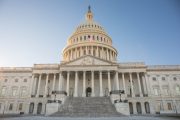
Congratulations, fellow Americans! As of August 19 you are finally working for your own benefit instead of the government’s. According to Americans for Tax Reform’s Center for Fiscal Accountability, the 2010 Cost of Government Day — “the date of the calendar year on which the average American worker has earned enough gross income to pay off his or her share of the spending and regulatory burden imposed by government at the federal, state and local level” — fell on August 19.
This is the latest COGD has fallen since the group began calculating it in 1977. It is eight days later than the 2009 COGD and a full 26 days later than in 2008. It’s also 51 days later than it was just 10 years ago.
While it’s tempting to blame President Barack Obama and Congressional Democrats for the explosion in government costs in the past two years, President George W. Bush and his party played a significant role, too. The two federal initiatives that have most increased costs since 2008 are the Troubled Asset Relief Program, signed into law by Bush with support from both parties in Congress, and the American Recovery and Reinvestment Act of 2009 (a.k.a. the “stimulus” law), for which Obama and fellow Democrats bear almost exclusive responsibility. In fact, if both these laws were repealed and remaining funds were not disbursed, COGD would fall 21 days earlier, on July 29. “That almost a month could be shed from COGD by repealing the remaining funds represents the unprecedented burden these spending policies have placed on taxpayers,” said the Center for Fiscal Accountability’s (CFA’s) report.
“Federal spending continues to be the single largest component of the total cost of government and the main driving force leading to the substantial increase in the cost of government over the last decade,” wrote the CFA. “The average American will have to work 104 days just to pay for the cost of federal spending, which will consume 28.6 percent of national income this year. This is a jump of over 25 days compared to 1999 and almost 14 days compared to 2008.”
State and local governments haven’t exactly been slackers in this department, either. The average American will work 52 days this year to make up for the profligacy of his state and local politicians. “In the last five years alone,” said the CFA, “state and local spending has grown by nearly 20 percent relative to national income.”
The variations in state spending and regulations mean that while August 19 is the average date on which COGD falls in 2010, Alaskans got off easy, working for the government “only” until July 28, while Connecticut residents will still be toiling away for their overseers until September 17.
Government employment, which has increased by 230,000 since 2009, also factors into the COGD equation. Calculating that the 40-year cost to taxpayers of a single federal employee is $4.27 million, the CFA argues that “President Obama has replaced or hired 250,000 federal employees, forcing a burden on taxpayers to the tune of over $1 trillion. This is during the same forty-year period where taxpayers will be on the hook to pay for the unfunded obligations of Social Security, Medicare, and Medicaid (not to mention the national debt).” The report also estimates that the stimulus law and other federal policies that mandate state and local government expansion “will result in a total government workforce of 24,315,000 at the federal, state and local levels.” On top of above-average salaries and benefits, there are the unbelievably generous pension plans at all levels of government, which will impose further enormous burdens on taxpayers when these bureaucrats retire.
“The average American will have to work 74 days in 2010 to pay for the cost of government regulation, which is estimated to consume 18.4 percent of national income,” according to the CFA. This estimate, says the CFA, “takes into account only the cost of complying with regulations.” It does not account for either the cost of enforcing the regulations or “the negative effects of regulatory requirements,” which, the report avers, “may be as large as the direct compliance costs of regulation. Economists at Washington University in St. Louis, leaders in the study of regulation, estimated these costs to be over $1.5 trillion per year in 2009.”
The report says that “these costs will certainly skyrocket with the advent of Obamacare,” mentioning the $1 billion in additional costs imposed on AT&T (and tens of millions of dollars on other corporations) to comply with the new law.
In a separate case study of ObamaCare, the CFA points out that it is difficult to calculate just how much the new system will cost because “proponents have repeatedly tried to hide the true costs by various accounting gimmicks and budgeting tricks,” in particular the ploy of having tax increases take effect years before benefits start being paid. Nevertheless, they ultimately estimate the law “will cost taxpayers about $2.3 trillion in the first ten years of implementation” and will almost certainly cost even more in the ensuing years. Using that estimate of a $230 billion annual cost to taxpayers means that if ObamaCare were fully implemented already, the 2010 COGD would have arrived 7 days later, on August 26.
The CFA is generally pessimistic about the prospects for reducing the cost of government, noting that the only way to do that is to cut spending, something for which politicians have little stomach. (House Majority Leader Steny Hoyer’s announcement that the House will not produce a budget for fiscal year 2011 is not encouraging.) However, they do recommend some existing proposals to help rein in spending, including Rep. Paul Ryan’s (R-Wis.) “Roadmap for America’s Future,” on which The New American has previously reported. They also suggest addressing tort reform; controlling public-employee wages, benefits, and pensions; empanelling a congressional commission to recommend spending cuts, and only spending cuts; and increasing transparency in government, both by creating websites to let taxpayers see how their money is being spent and by enacting a mandatory five-day waiting period between the time a bill is presented to legislators and the time they vote on it.
The dictionary defines slavery as “the subjection of a person to another person, especially in being forced into work.” Nothing better describes a system in which people are required to toil eight months out of every year to the benefit of their masters in Washington and various other seats of power. Is it any wonder, then, that we are beginning to see signs of a slave revolt in the Tea Parties and other citizen activism — and that the ruling class fears such an uprising?

